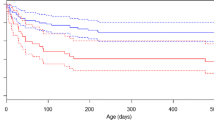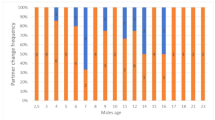Abstract
Studies of wild callitrichids provide conflicting evidence regarding polyandrous groups. One perspective supports a monopolizing breeding strategy on the part of one male, while the alternative perspective suggests that polyandry does not lead to a breeding monopoly. We tested the hypotheses in male marmosets (Callithrix kuhlii) with 5 polyandrous groups composed of related/familiar males as our attempts to establish polyandrous groups of unrelated/familiar males failed. We monitored male social and sexual behavior and urinary testosterone (T) and cortisol (CORT) across the first 80 days of group formation and contrasted them with similar measures in males housed in monogamous groups. We also examined the same measures across the females' ovulatory cycles for polyandrous males. We found little evidence that males in polyandrous groups exercised a mating monopoly over the female and no evidence for overt competition between polyandrous males. We found 2 behavioral differences: polyandrous males were less often in proximity and copulated more often with the female than monogamous males did. Our findings suggest that the males in newly-formed groups of marmosets do not monopolize breeding and social behavior with the female. This appears to be the case for 3 reasons. First, males may use sperm competition rather than overt competition. Secondly, it may take longer for relationships to develop between the female and the males in polyandrous groups versus in monogamous groups. Thirdly, the cost of infant care is sufficiently high to demand that group members get along when groups are small and reproductive benefits are shared.
Similar content being viewed by others
References
Abbott, D. H. (1993). Social conflict and reproductive suppression in marmoset and tamarin monkeys. In: Mason, W. A., and Mendoza, S. P (eds.), Primate Social Conflict, State University of New York Press, New York, pp. 331–372.
Achenbach, G. G., and Snowdon, C. T. (2002). Costs of caregiving: Weight loss in captive adult male cotton-top tamarins (Saguinus oedipus) follow the birth of infants. Int. J. Primatol. 23: 179–189.
Baker, A. J., and Dietz, J. M. (1996). Immigration in wild groups of golden lion tamarins (Leontopithecus rosalia). Am. J. Primatol. 38: 47–56.
Baker, A. J., Dietz, J. M., and Kleiman, D. G. (1993). Behavioral evidence for monopolization of paternity in multi-male groups of golden lion tamarins. Anim. Behav. 46: 1091–1103.
Baker, J. V., Abbott, D. H., and Saltzman, W. (1999). Social determinants of reproductive failure in male common marmosets housed with their natal family. Anim. Behav. 58: 501–513.
Burtis, C. A., and Ashwood, E. R. (2001). Tietz Fundamentals of Clinical Chemistry, Saunders, Philadelphia.
Clutton-Brock, T. H. (1989). Mammalian mating systems. Proc. R. Soc. Lond. B. 236: 339–372.
Clutton-Brock, T. H. (1998). Reproductive skew, concessions and limited control. Trends Ecol. Evol. 13: 288–292.
Creel, S. R., and Creel, N. M. (1991). Energetics, reproductive suppression and obligate communal breeding in carnivores. Behav. Ecol. Sociobiol. 28: 263–270.
Creel, S. R., and Creel, N. M. (2002). The African Wild Dog: Behaviour, Ecology and Conservation, Princeton University Press, Princeton.
Creel, S. R., Creel, N., Wildt, D. E., and Monfort, S. L. (1992). Behavioural and endocrine mechanisms of reproductive suppression in Serengeti dwarf mongooses. Anim. Behav. 43: 231–245.
Deitz, J. M., and Baker, A. J. (1993). Polygyny and female reproductive success in golden lion tamarins (Leontopithecus rosalia). Anim. Behav. 46: 1067–1078.
Digby, L. J. (1995). Social organization in a wild population of Callithrix jacchus: II. Intra-group social behavior. Primates 36: 361–375
Dixson, A. F. (1993). Callitrichid mating systems: Laboratory and field approaches to studies of monogamy and polyandry. In Rylands A. B. (ed.), Marmosets and Tamarins: Systematic, Behavior, and Ecology, Oxford University Press, Oxford, pp. 164–175.
Dunbar, R. I. M. (1995). The mating system of callitrichid primates: II. The impact of helpers. Anim. Behav. 50: 1071–1089.
Emlen, S. T., and Oring, L. W. (1977). Ecology, sexual selection and the evolution of mating systems. Science 197: 215–223.
Epple, G. (1975). The behavior of the marmoset monkeys (Callitrichidae). In Rosenblum, L. A. (ed.), Primate Behavior, Vol. 4, Academic Press, New York, pp. 195–239.
Ferrari, S. F. (1992). The care of infants in a wild marmoset, Callithrix flaviceps, group. Am. J. Primatol. 26: 109–118.
Ferrari, S. F., and Digby, L. J. (1996). Wild Callithrix groups: Stable extended families? Am. J. Primatol. 38: 19–27.
French, J. A. (1997). Proximate regulation of singular breeding in callitrichid primates. In: Solomon, N. G., and French, J. A. (eds.), Cooperative Breeding in Mammals, Cambridge University Press, Cambridge, pp. 40–81.
French, J. A., Brewer, K. J., Schaffner, C. M., Hightower-Merritt, D., Smith, T. E., and Bell, S. M. (1996). Urinary steroid and gonadotropin excretion across the reproductive cycle in female black tufted-ear marmosets (Callithrix kuhli). Am. J. Primatol. 40: 231–246.
French, J. A., and Schaffner, C. M. (1995). Social and developmental influences on urinary testosterone levels in male black tufted-ear marmosets (Callithrix kuhli). Am. J. Primatol. 36: 123.
French, J. A., and Schaffner, C. M. (1999). Contextual influences on sociosexual behavior in monogamous primates. In Wallen, K., and Schneider, J. E. (eds.), Reproduction in Context: Social and Environmental Influences on Reproduction, MIT Press, Cambridge, pp. 325–353.
Garber, P. A., Encarnación, F., Moya, L., and Pruetz, J. D. (1993). Demographic and reproductive patterns in moustached tamarin monkeys (Saguinus mystax): Implications for reconstructing platyrrhine mating systems. Am. J. Primatol. 29: 235–254.
Garber, P. A., Encarnación, F., Moya, L., Pruetz, J. D., and Ique, C. (1996). Social and seasonal influences on reproductive biology in male moustached tamarins (Saguinus mystax). Am. J. Primatol. 38: 29–46.
Garber, P. A., Moya, L., and Malago, C. A. (1984). A preliminary field study of the moustached tamarins monkey (Saguinus mystax) in northeastern Peru: Questions concerned with the evolution of a communal breeding system. Folia Primatol. 42: 17–32.
Ginther, A. J., Ziegler, T. E., and Snowdon, C. T. (2001). Reproductive biology of captive male cottontop tamarin monkeys as a function of social environment. Anim. Behav. 61: 65–78.
Goldizen, A. W. (1987). Facultative polyandry and the role of infant-carrying in wild saddle-back tamarins (Saguinus fuscicollis). Behav. Ecol. Sociobiol. 20: 99–109.
Goldizen, A. W., Mendelson, J., and Terborgh, J. (1996). Saddle-back tamarins (Saguinus fuscicollis) reproductive strategies: Evidence from a thirteen-year study of a marked population. Am. J. Primatol. 38: 57–84.
Harcourt, A. H., Harvey, P. H., Larson, S. G., and Short, R.V. (1981). Testis weight, body weight, and breeding system in primates. Nature 293: 55–57.
Heymann, E. W. (1996). Social behavior of wild moustached tamarins, Saguinus mystax, at the Estacion Biologica Quebrada Blanco, Peruvian Amazonia. Am. J. Primatol. 38: 85–100.
Hinde, R. A., and Atkinson, S. (1970). Assessing the roles of social partners in maintaining mutual proximity, as exemplified by mother-infant relations in rhesus monkeys. Anim. Behav. 18: 169–176.
Keane, B., Waser, P. M., Creel, S. R., Creel, N. M., Elliott, L. F., and Minchella, D. J. (1994). Subordinate reproduction in dwarf mongooses. Anim. Behav. 47, 65–75.
Keller, L., and Reeve, H. K. (1994). Partitioning of reproduction in animal societies. Trends Ecol. Evol. 9: 98–102.
Keppel G. (1993). Design and Analysis: A Researcher's Handbook, Prentice Hall, Englewood Cliffs, NJ.
Kleiman, D. G. (1978). The development of pair preferences in the lion tamarins (Leontopithecus rosalia): Male competition or female Choice? In Rothe, H., Wolters H. J., and Hearn, J. (eds.), Biology and Behavior of Marmosets, Eigenverlag H. Rothe, Gottingen, pp. 203–207.
Lazaro-Perea, C., Castro, C. C. S., Harrison, R., Araujo, A., Arruda, M. F., and Snowdon, C. T. (1999). Behavioral and demographic changes following the loss of the breeding female in cooperatively breeding marmosets. Behav. Ecol. Sociobiol. 48: 137–146.
Nievergelt, C. M., and Martin, R. D. (1999). Energy intake during reproduction in captive common marmosets (Callithrix jacchus). Physiol. Behav. 65: 849–854.
Nunes, S., Fite, F. E., and French, J. A. (2000). Variation in steroid hormones associated with infant care behavior and experience in male marmosets (Callithrix kuhlii). Anim. Behav. 60: 857–865.
Nunes, S., Fite, J. E., Patera, K. J., and French, J. (2001). Interactions among peternal behavior, steroid hormones, and parental experience in male marmosets (Callithrix kuhlii). Horm. Behav. 39: 70–82.
Price, E. C., and McGrew, W. C. (1991). Departures from monogamy: survey and synthesis from colonies of cotton-top tamarins. Folia Primatol. 57: 16–27.
Rothe, H., and Darms, K. (1993). The social organization of marmosets: A critical evaluation of recent concepts. In Rylands, A. B. (ed.), Marmosets and Tamarins: Systematic, Behaviour, and Ecology, Oxford University Press, Oxford. pp. 177–199
Rothe, H., and Koenig, A. (1991). Variability of social organization in captive common marmosets (Callithrix jacchus). Folia Primatol. 57: 28–33.
Rylands, A. (1996). Habitat and the evolution of social and reproductive behavior in callitrichidae. Am. J. Primatol. 38: 5–18.
Saino, N., and Møller, A. P. (1995). Testosterone-induced depression of male parental behavior in the barn swallow: Female compensation and effects on seasonal fitness. Behav. Ecol. Sociobiol. 36: 151–157.
Sánchez, S. P., Gil-Bürmann, C., and Kaumanns, W. (1999). Costs of infant-carrying in the cotton-top tamarin (Saguinus oedipus). Am. J. Primatol. 48: 99–111.
Santos, C. V., French, J. A., and Otta, E. (1997). Infant carrying behavior in callitrichid primates: Callithrixand Leontopithecus. Folia Primatol. 18: 889–908.
Savage, A., and Baker, A. (1996). Callitrichid social structure and mating system: Evidence from field studies. Am. J. Primatol. 38: 1–4.
Schaffner, C. M., and French, J. A. (1997). Group size and aggression: [Recruitment incentives] in a cooperatively breeding primate. Anim. Behav. 54: 171–180.
Schaffner, C.M., Shepherd, R. E., Santos, C. V., and French, J. A. (1995). Development of heterosexual relationships in Wied's black tufted-ear marmosets (Callithrix kuhli). Am. J. Primatol. 36: 185–200.
Smith, T. E., and French, J. A. (1997). Psychosocial stress and urinary cortisol excretion in marmoset monkeys (Callithrix kuhli). Physiol. Behav. 62: 225–232.
Smith, T. E., McGreer-Whitworth, B., and French, J. A. (1998). Close proximity of the heterosexual partner reduces the physiological and behavioral consequences of novel-cage housing in black tufted-ear marmosets (Callithrix kuhli). Horm. Behav. 34: 211–222.
Soini, P. (1987). Sociosexual behavior of a free-ranging Cebuella pygmaea (Callitrichidae: Platyrrhini) troop during postpartum estrus of its reproductive female. Am. J. Primatol. 13: 223–230.
Solomon, N. G., and French, J. A. (1997). The study of mammalian cooperative breeding. In Solomon, N. G., and French, J. A. (eds.), Cooperative Breeding in Mammals, Cambridge University Press, Cambridge, pp. 1–10.
Tardif, S. D., Carson, R. L., and Gangaware, B. L. (1986). Comparison of infant care in family groups of the common marmoset (Callithrix jacchus) and the cotton-top tamarin (Saguinus oedipus). Am. J. Primatol. 11: 103–110.
Trivers, R. L. (1972). Parental investment and sexual selection. In Campbell, B. (ed.), Sexual Selection and the Descent of Man 1871–1971, Aldine Publishing Company Chicago, pp. 136–179.
Wingfield, J. C., Hegner, R. E., Dufty, A. M., Jr., and Ball, G. F. (1990). The “challenge hypothesis”: Theoretical implications for patterns of testosterone secretion, mating systems, and breeding strategies. Am. Nat. 136: 829–846.
Author information
Authors and Affiliations
Corresponding author
Rights and permissions
About this article
Cite this article
Schaffner, C.M., French, J.A. Behavioral and Endocrine Responses in Male Marmosets to the Establishment of Multimale Breeding Groups: Evidence for Non-monopolizing Facultative Polyandry. International Journal of Primatology 25, 709–732 (2004). https://doi.org/10.1023/B:IJOP.0000023582.34854.43
Issue Date:
DOI: https://doi.org/10.1023/B:IJOP.0000023582.34854.43




